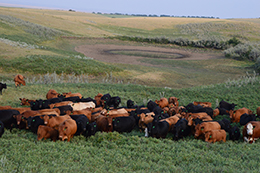Decision Making During Drought
Producers coping with severe drought and feed shortages have tough decisions to make about culling, weaning and cow management. The following considerations may be helpful when making herd decisions in the coming weeks and into the fall:
Culling
- Know what feed sources you have available and the true nutritional quality of them so you can make the best decisions for your herd. Sending representative feed samples to a lab for analysis and working with a nutritionist or livestock specialist who can interpret the results and help develop balanced rations is crucially important.
- Prevent cows you plan to keep in the herd from losing too much condition. Cows with an ideal amount of fat cover (a body condition score of 3.0) eat less and are easier to maintain through the winter and get rebred. Cull early to help keep the remainder of the herd in good condition.
- Now is a good time to let go of any cattle you have let slide through in previous culls. Check your records. Cull anything that has a bad temperament, that has been treated repeatedly for health issues or that weans calves that perform below your herd benchmarks.
- The value of the investment in pregnancy checking your herd is even more evident in dry years as it allows you to cull any open or late-calving cows.
- Consider culling any bulls that are older or that are producing less desirable progeny based on your records.
After working through these initial decisions, you may still be faced with the need to cull a larger portion of your herd. Producers are often then faced with the decision of whether to keep cows or bred heifers. Both choices have their advantages and disadvantages:
- Heifers may often be introducing newer genetics, while cows are more likely to be adapted to your specific environment and management practices.
- Heifers are more likely to stay in your herd longer, but cows have probably already paid for themselves with a number of calves produced.
- Heifers eat less feed but require higher quality feed to allow them to grow and produce a healthy calf; heifers are less likely to be rebred after their first calf if nutrition is lacking.
- Heifers are more likely to require added labour at calving time.
Early weaning
Although early weaning has many benefits to the cow herd, those early-weaned calves bring different management challenges. Producers may need to retain ownership to get the most value out of the calves, in which case they must determine the best strategies for feeding calves separately.
General advantages of early weaning for the cow herd include:
- Cows are more likely to maintain an adequate body condition when they are not producing milk. Ideal body condition is linked to:
- fewer problems at calving,
- more cows rebred next year and
- there is some evidence to suggest cows that have their calf weaned early have a larger calf the following year.
- Reduced stress on the pasture and overall feed requirements because calves consume a significant amount of forage when with their dams.
Drylot the cow herd
For those that are used to extended grazing, this method may reduce the stress on pastures and help get cows through the winter. Things to consider with this option:
- It is often easier to maintain cow condition in a drylot, but it comes at an added cost.
- Whether it’s sending the cows to a feedlot or drylotting cattle at home, run the numbers to be sure the economics make sense.
- If cows are being managed in a feedlot, keep in mind they will probably be comingled or share a fence with other herds which will present disease risks.
- Reduced exercise may result in difficulties at calving.
What did we miss?
Help us share useful information with other producers in similar situations. Comment below with the things you’re considering as you work through these decisions this fall.
More information
View more drought-related resources for cattle producers available on BeefResearch.ca.
Click here to subscribe to the BCRC Blog and receive email notifications when new content is posted.
The sharing or reprinting of BCRC Blog articles is welcome and encouraged. Please provide acknowledgement to the Beef Cattle Research Council, list the website address, www.BeefResearch.ca, and let us know you chose to share the article by emailing us at [email protected].
We welcome your questions, comments and suggestions. Contact us directly or generate public discussion by posting your thoughts below.
